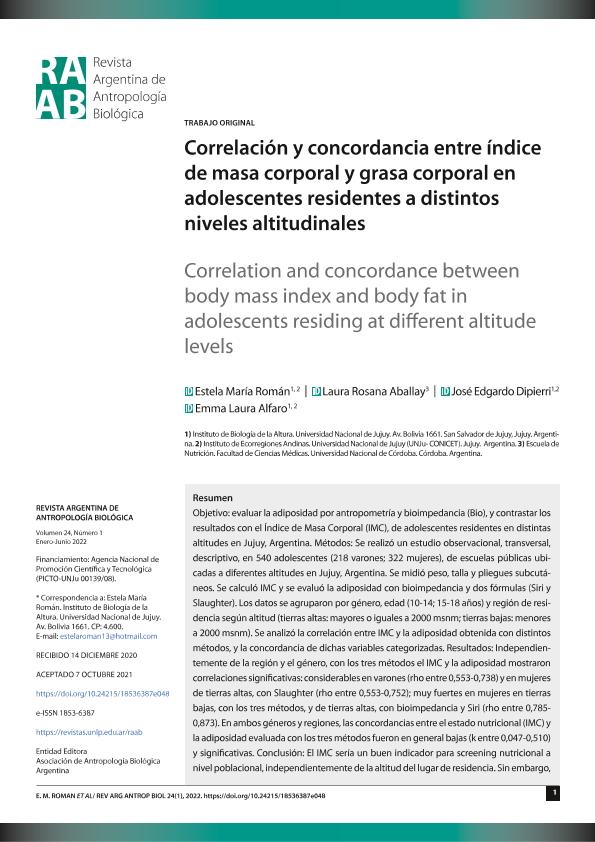Artículo
Objetivo: evaluar la adiposidad por antropometría y bioimpedancia (Bio), y contrastar los resultados con el Índice de Masa Corporal (IMC), de adolescentes residentes en distintas altitudes en Jujuy, Argentina. Métodos: Se realizó un estudio observacional, transversal, descriptivo, en 540 adolescentes (218 varones; 322 mujeres), de escuelas públicas ubicadas a diferentes altitudes en Jujuy, Argentina. Se midió peso, talla y pliegues subcutáneos. Se calculó IMC y se evaluó la adiposidad con bioimpedancia y dos fórmulas (Siri y Slaughter). Los datos se agruparon por género, edad (10-14; 15-18 años) y región de residencia según altitud (tierras altas: mayores o iguales a 2000 msnm; tierras bajas: menores a 2000 msnm). Se analizó la correlación entre IMC y la adiposidad obtenida con distintos métodos, y la concordancia de dichas variables categorizadas. Resultados: Independientemente de la región y el género, con los tres métodos el IMC y la adiposidad mostraron correlaciones significativas: considerables en varones (rho entre 0,553-0,738) y en mujeres de tierras altas, con Slaughter (rho entre 0,553-0,752); muy fuertes en mujeres en tierras bajas, con los tres métodos, y de tierras altas, con bioimpedancia y Siri (rho entre 0,785-0,873). En ambos géneros y regiones, las concordancias entre el estado nutricional (IMC) y la adiposidad evaluada con los tres métodos fueron en general bajas (k entre 0,047-0,510) y significativas. Conclusión: El IMC sería un buen indicador para screening nutricional a nivel poblacional, independientemente de la altitud del lugar de residencia. Sin embargo,a nivel individual sería necesario complementarlo con métodos de valoración de adiposidad. Objective: to evaluate the percentage of body fat (%BF) in adolescents from Jujuy, Argentina, with anthropometry and bioimpedance (Bio), and contrast the results with the body mass index (BMI), considering the altitude level in which the adolescents studied reside. Methods: An observational, cross-sectional, descriptive study was carried out in 540 adolescents (218 men; 322 women), from public schools in different regions of Jujuy. Weight, height, skinfold thickness and %BF Bio were measured. BMI and %BF were calculated with two equations (Siri and Slaughter). The data were grouped by sex, age (10-14; 15-18 years) and region of origin (highlands ≥2.000 m.a.s.l.; lowlands <2.000 m.a.s.l.). The correlation between BMI and % BF obtained with different methods, and the agreement of these categorized variables were analyzed. Results: Regardless of region and sex, with the three methods BMI and adiposity showed significant correlations: considerable in males (rho between 0.553-0.738) and in women from highlands, with Slaughter (rho between 0.553-0.752); very strong in women from lowlands, with the three methods, and from highlands, with Bio and Siri (rho between 0.785-0.873). In both sexes and regions, the concordances between nutritional status (BMI) and adiposity evaluated with the three methods were generally low (k between 0.047-0.510) and significant. Conclusion: BMI might be a good indicator for nutritional screening at population level, regardless of the altitude of the place of residence. However, at an individual level it seems necessary to complement it with adiposity assessment methods.
Correlación y concordancia entre índice de masa corporal y grasa corporal en adolescentes residentes a distintos niveles altitudinales
Título:
Correlation and concordance between body mass index and body fat in adolescents residing at different altitude levels
Fecha de publicación:
03/2022
Editorial:
Asociacion Argentina de Antropologia Biológica; Universidad Nacional de La Plata
Revista:
Revista Argentina de Antropologia Biológica
e-ISSN:
1853-6387
Idioma:
Español
Tipo de recurso:
Artículo publicado
Clasificación temática:
Resumen
Palabras clave:
ADIPOSITY
,
ALTITUDE
,
NUTRITIONAL STATUS
Archivos asociados
Licencia
Identificadores
Colecciones
Articulos(INECOA)
Articulos de INSTITUTO DE ECORREGIONES ANDINAS
Articulos de INSTITUTO DE ECORREGIONES ANDINAS
Citación
Román, Estela María; Aballay, Laura Rosana; Dipierri, Jose Edgardo; Alfaro Gómez, Emma Laura; Correlación y concordancia entre índice de masa corporal y grasa corporal en adolescentes residentes a distintos niveles altitudinales; Asociacion Argentina de Antropologia Biológica; Universidad Nacional de La Plata; Revista Argentina de Antropologia Biológica; 24; 1; 3-2022; 1-14
Compartir
Altmétricas




